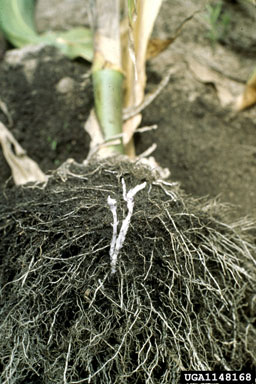Interactions
Please play nice with others.
Humans:
Pseudomonas aeruginosa is not a bacterium that hospitals
appreciate. This bacterium has become very common in the hospital
setting due to its increasing resistance to antibiotics and common
disinfectants used to sanitize counters and other surfaces. Movement
within a hospital is not a problem for Pseudomonas aeruginosa
because it can be so easily transferred through casual hand-to-hand contact. Additionally, it can hide in lotions,
soaps and other aqueous solutions where it waits for an unsuspecting
person to come along and pick it up and become infected. Even
healthy people can unknowingly carry this bacterium in their
gastrointestinal tracts. However, people whose immune systems are
suppressed by age or disease are especially susceptible to the
bacteria’s infectious nature. Hospitals can have a perfect storm of
infection brewing in them due to a combination of weaken patients to
infect and intense selection pressures that are producing superior
strains of this bacteria that are resistance to their best measures
to control and eliminate it.
casual hand-to-hand contact. Additionally, it can hide in lotions,
soaps and other aqueous solutions where it waits for an unsuspecting
person to come along and pick it up and become infected. Even
healthy people can unknowingly carry this bacterium in their
gastrointestinal tracts. However, people whose immune systems are
suppressed by age or disease are especially susceptible to the
bacteria’s infectious nature. Hospitals can have a perfect storm of
infection brewing in them due to a combination of weaken patients to
infect and intense selection pressures that are producing superior
strains of this bacteria that are resistance to their best measures
to control and eliminate it.
Above picture: hand contact is a good way to pick up
Pseudomonas aeruginosa. Picture from
WikiCommons.
Infections:
Pseudomonas aeruginosa causes a wide range of infections in
humans. People who are most at risk include those with HIV, those
with suppressed immune systems, individuals with cystic fibrosis or
diabetes, and even people with cancer.
Pseudomonas aeruginosa and burns:
Burns destroy the layers of the skin as well as parts of the immune
system--prime for Pseudomonas aeruginosa. Open wounds
caused by burns, combined with the suppression of the immune
systems, allows the bacteria to colonize in the wound.
Right: picture of a burn- asking to be infected. Image from
WikiCommons.
Pseudomonas aeruginosa and swimmer’s
ear:
It is not uncommon to find some Pseudomonas aeruginosa in a
healthy person’s ear. However, those individuals who often expose
themselves to water make conditions in the ear canal optimal for the
growth of this bacterium. In fact, it causes about 70% of the
diagnosed cases of swimmer’s ear.
For more information about swimmer's ear, visit:
Centers for Disease Control and Prevention
Respiratory infections:
Pseudomonas aeruginosa loves to infect individuals with
cystic fibrosis.
Background: Cystic fibrosis is a genetically inherited disease
that is life threatening because it affects the cells (exocrine
glands) in the lungs and digestive tract that are responsible for
producing mucus and digestive fluids.
As I said on my habitat page, Pseudomonas aeruginosa has an
affinity for moist environments, making the mucus of the lung’s and
digestive tract a wonderful place to colonize. Once Pseudomonas
aeruginosa has colonized, it surrounds itself by mucoid, a
polysaccharide made of alginate. This mucoid biofilm layer makes it
difficult to treat an infection of Pseudomonas aeruginosa.
Infections of this bacterium cause the lungs to become inflamed,
this damages the tissues in the lungs leading to the production of
scar tissue and reduced respiratory function. The long-term presence
of Pseudomonas aeruginosa in cystic fibrosis patients most
commonly is what causes death.
Eye infections:
These infections usually occur because of contaminated contact
lenses or a scratch on the cornea. Once Pseudomonas aeruginosa
begins to colonize on the eye, enzymes created by the bacteria begin
to deteriorate the cornea, which causes ulcers. If eye infections
are not caught right away, they can lead to permanent damage such as
vision loss and even blindness.
For more information about illness caused by Pseudomonas aeruginosa, visit:
Animals:
Just like humans, many animals carry Pseudomonas aeruginosa
and are not affected by it. However, these bacteria can also
cause infections. Some effects that Pseudomonas aeruginosa
can have on animals include spontaneous abortion, genital
infections, ear infections, and respiratory infections. Some species
that are affected by these bacteria include
dogs,
cats,
and
sheep.



Above and below pictures: All organisms that Pseudomonas
aeruginosa can infect. Pictures from
WikiCommons.

Plants:
Oddly enough, plants can also become infected by Pseudomonas
aeruginosa. As I said on the habitat page, these bacteria can
be found in the soil. Because of this, it isn’t too out there to see
why plants also becoming infected. Pseudomonas aeruginosa,
much like in animals/ humans, are parasitic to plants.
Pseudomonas aeruginosa ends up creating a biofilm layer over
the root tips of plants in order to protect itself from the enzymes
secreted from the roots. This biofilm layer ultimately causes the
death of the plant.
Want to know some fun facts? Head on over to my next page! (Facts)
